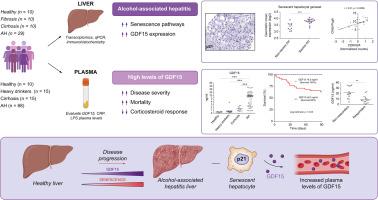GDF15 is associated with hepatocellular senescence and correlates with mortality in patients with alcohol-associated hepatitis
IF 7.5
1区 医学
Q1 GASTROENTEROLOGY & HEPATOLOGY
引用次数: 0
Abstract
Background & Aims
Cellular senescence is characterized by the loss of proliferative capacity, cell cycle arrest, and the acquisition of a proinflammatory senescence-associated secretory phenotype (SASP). Senescence is frequently present in advanced chronic liver diseases; however, the impact of hepatocellular senescence in alcohol-associated liver disease (ALD) progression and alcohol-associated hepatitis (AH) is poorly understood.
Methods
Senescence was evaluated in transcriptomic data from patients at different ALD stages: advanced fibrosis (n = 10), cirrhosis (n = 10), and AH (n = 29). Plasma GDF15 levels were tested in patients with AH (n = 68), compensated cirrhosis (n = 15), heavy drinkers without liver disease (n = 15), and healthy controls (n = 10). Results were confirmed in an independent validation cohort.
Results
Transcriptomic analysis revealed an increased expression of senescence-associated genes and an enrichment of SASP gene signatures in patients with cirrhosis and particularly with AH. The association of senescence with AH was confirmed by p21 staining and the expression of senescence markers (i.e. CDKN1A, CDKN2A, CDKN2B, IL6, and SERPINE1), which positively correlated with clinical severity scores. Among the SASP factors, GDF15 was expressed in the hepatocytes of patients with AH and was strongly associated with senescence markers. Circulating GDF15 levels were specifically increased in patients with AH and positively correlated with severity scores. Moreover, plasma GDF15 levels predicted the response to corticosteroids and 90-day mortality in two independent cohorts of patients with AH.
Conclusions
These results suggest that AH is characterized by the presence of hepatocellular senescence and elevated circulating levels of SASP factors, particularly GDF15, which correlates with patients’ poor outcomes. This suggests that senescence may be both a player in AH pathogenesis and a potential biomarker for AH.
Impact and implications
The pathogenesis of alcohol-associated liver disease (ALD) and hepatitis (AH) remains to be fully elucidated, and there is a need for biomarkers that can effectively monitor disease progression and assess patient response to therapy. In this study, we show the association of AH with hepatocellular senescence and the hepatic expression of senescence-associated secretory phenotype (SASP) factors, which correlate with poor patient outcome. Furthermore, we provide evidence that SASP factors such as GDF15 may be potential plasma biomarkers for AH. The findings of this study lay the groundwork for future research into the role of senescence in the pathogenesis of AH, as well as into the potential use of senescence and SASP-related molecules as biomarkers for AH.

GDF15与酒精相关性肝炎患者的肝细胞衰老和死亡率相关
背景,细胞衰老的特征是增殖能力丧失,细胞周期停滞,以及获得促炎衰老相关的分泌表型(SASP)。衰老经常出现在晚期慢性肝病中;然而,肝细胞衰老在酒精相关性肝病(ALD)进展和酒精相关性肝炎(AH)中的影响尚不清楚。方法通过不同ALD阶段患者的转录组学数据评估衰老:晚期纤维化(n = 10)、肝硬化(n = 10)和AH (n = 29)。在AH患者(n = 68)、代偿性肝硬化患者(n = 15)、无肝病的重度饮酒者(n = 15)和健康对照组(n = 10)中检测血浆GDF15水平。结果在一个独立的验证队列中得到证实。结果转录组学分析显示,肝硬化患者,特别是AH患者,衰老相关基因表达增加,SASP基因特征丰富。p21染色及衰老标志物(CDKN1A、CDKN2A、CDKN2B、IL6、SERPINE1)表达与临床严重程度评分呈正相关,证实了AH与衰老的相关性。在SASP因子中,GDF15在AH患者的肝细胞中表达,并与衰老标志物密切相关。循环GDF15水平在AH患者中特异性升高,并与严重程度评分呈正相关。此外,血浆GDF15水平预测了两个独立队列AH患者对皮质类固醇的反应和90天死亡率。这些结果表明,AH的特点是存在肝细胞衰老和循环中SASP因子水平升高,特别是GDF15,这与患者的不良预后相关。这表明衰老可能既是AH发病机制的一个参与者,也是AH潜在的生物标志物。影响和意义酒精相关性肝病(ALD)和肝炎(AH)的发病机制仍未完全阐明,需要能够有效监测疾病进展和评估患者对治疗反应的生物标志物。在这项研究中,我们展示了AH与肝细胞衰老和衰老相关分泌表型(SASP)因子的肝脏表达的关联,这些因子与患者预后不良相关。此外,我们提供证据表明SASP因子如GDF15可能是AH的潜在血浆生物标志物。本研究结果为进一步研究衰老在AH发病机制中的作用,以及衰老和sasp相关分子作为AH生物标志物的潜在应用奠定了基础。
本文章由计算机程序翻译,如有差异,请以英文原文为准。
求助全文
约1分钟内获得全文
求助全文
来源期刊

JHEP Reports
GASTROENTEROLOGY & HEPATOLOGY-
CiteScore
12.40
自引率
2.40%
发文量
161
审稿时长
36 days
期刊介绍:
JHEP Reports is an open access journal that is affiliated with the European Association for the Study of the Liver (EASL). It serves as a companion journal to the highly respected Journal of Hepatology.
The primary objective of JHEP Reports is to publish original papers and reviews that contribute to the advancement of knowledge in the field of liver diseases. The journal covers a wide range of topics, including basic, translational, and clinical research. It also focuses on global issues in hepatology, with particular emphasis on areas such as clinical trials, novel diagnostics, precision medicine and therapeutics, cancer research, cellular and molecular studies, artificial intelligence, microbiome research, epidemiology, and cutting-edge technologies.
In summary, JHEP Reports is dedicated to promoting scientific discoveries and innovations in liver diseases through the publication of high-quality research papers and reviews covering various aspects of hepatology.
 求助内容:
求助内容: 应助结果提醒方式:
应助结果提醒方式:


